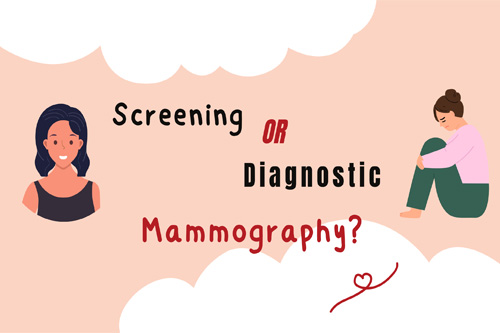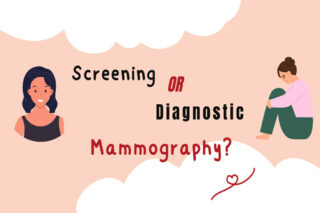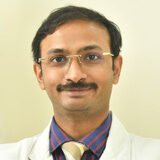Screening vs Diagnostic Mammogram: Why Should You Know the Difference?

Screening vs Diagnostic Mammogram: Why Should You Know the Difference?
Dr. Raja Shanmuga Krishnan R
India’s Leading Breast Cancer Expert
 Should you do your mammogram only when you feel a symptom or every year even when you feel in perfect health?
Should you do your mammogram only when you feel a symptom or every year even when you feel in perfect health?
Your choice may mean a difference between long life and early death.
No, I am not joking. Let’s see why.
What is a Diagnostic Mammogram?
Let’s say you feel a breast lump, pain, nipple discharge, rashes or redness near the nipples, or some symptom that you report to your doctor. The doctor asks you to get a mammogram done to examine further. This is a diagnostic mammogram, carried out because of your symptoms.
What’s wrong with it? Don’t you need to see a doctor only when you have a problem?
Not a good idea for breast cancer.
If breast cancer is diagnosed after a symptom, it probably is late, vastly harming the chances of a complete cure.
Whereas an early diagnosis of breast cancer dramatically improves the chances of complete cure and disease-free survival with 93% or higher survival rates in the first five years.[1]
Just like many cancers, breast cancer begins as one bad cell, which then divides into two bad cells, which quietly divide again and become four bad cells, and so on. With most breast cancers, each division takes one to two months. So, by the time you can feel the lump or another symptom, the cancer is already two to five years old and far more dangerous.[2]
Early breast cancer mostly has no symptoms. Early detection is the best protection against it. No one can prevent breast cancer either.
This is why a routine screening mammogram becomes vital for all women above 40 years of age. And if you are in a high-risk category, your doctor may ask you to begin screening at a younger than 40.
Screening Mammograms Save Lives
First, let’s discuss why not any other modality but a mammogram is the best way for routine breast screening for most women of screening age.[3]
Three popular but ineffective methods for routine screening are breast self-exams, ultrasound, and MRI.
- Breast self-examination is not recommended by most medical organizations across the world[4] because it does not help early detection. By the time the lump is big enough to be felt by your or your doctor’s hands, it’s already too big, and too late.
- Ultrasound is more useful for further diagnosing a suspicious finding than for regular screening because it can neither capture the whole image of the breast nor see deep like a mammogram.
- MRI’s high cost and lower ability to correctly exclude women without breast cancer prohibit its routine use for screening.[5]
Whereas Mammography is the gold standard for routine screening and early detection of breast cancer.[6]
Breast cancer deaths are reduced by 30% to 50% with annual screening mammography performed on all women beginning at age 40 years.[7]
Routine Screening Mammograms Can Save Your Medical Expenses Too
Annual screening mammograms can substantially reduce your stress & medical expenses: Just like car insurance premiums, spending a small amount on mammography every year may help you save 30% to over 100% of the treatment costs of breast cancer compared to the women who are diagnosed with advanced-stage breast cancers7.
You may also avoid the need for chemotherapy, removing the entire breasts, etc., with early detection with mammography.
How to Select an Appropriate Center for Your Mammogram?
You deserve access to the best of technology & facilities when it’s time for your annual mammogram.
Here are two easy steps to help you navigate well in choosing the right Mammography Centre, whether it’s in a hospital, a diagnostic lab, or a breast clinic:
1. Is Digital (at least) or the latest 3D Mammography available at the center?
- In the newer digital & the latest 3D mammography, the image is directly captured by the computer, which can be magnified, enhanced, etc., for detailed evaluation when needed. In the old analog machines, films were used to capture images.
- The latest 3D mammography machines in the digital family are designed to deliver the fastest and the highest resolution mammograms, with more comfort, and at the lowest radiation dose within the allowable limits.
- Studies have shown that 3D mammography significantly helps in early breast cancer detection, enabling the detection of more cancer cells[8], and significantly reducing recall rates[9] for any additional tests.
- 3D mammography is especially useful in high-risk women, i.e., including those with:
- Changes or lumps in the breasts
- A family history of breast or ovarian cancer[10]
- Dense breast tissue (nearly half of all women above the age of 40 have dense breasts)[11]
- A previous diagnosis of breast disease
2. Does the center have other relevant capabilities for mammography?
- Radiologists are specialist medical doctors who study your mammograms and interpret the scans for you. Usually, the website of the center will have detailed information about the doctor’s qualifications, experience, advanced training or fellowship in radiology, etc. This may give you a good idea about the professional expertise at the Centre.
- Mammography is only an imaging test that has no cuts or pricks. There is no admission to the hospital, etc. You can either take a prior appointment or walk-in if the center advises mammography which usually takes only a few minutes excluding waiting time. Within those few minutes, your breast tissue will be compressed only for less than 10 seconds in the latest 3D Mammography machines to take clear images and avoid recalls.
- Most health plans cover the cost of mammography if you are insured for diagnostic tests. Even if it’s not, the cost of mammography is negligible compared to the benefits it provides.
If you are eligible for breast screening either by age (40 years and above) or due to high-risk factors such as family history (in which case even if you are younger than 40 years), subscribe to an Annual Screening Mammography Plan right away– A simple ritual that can save your life!

Dr. Raja Shanmuga Krishnan R., Consultant Breast Oncoplastic Surgeon
MBBS, MS (Gen), MRCS, DNB (Plastic)
Ganga Hospital, Coimbatore
- https://www.carolmilgardbreastcenter.org/early-detection Accessed on 28 Feb 2023
- https://oregon.providence.org/forms-and-information/a/ask-an-expert-breast-cancer-growth-rate/ Accessed on 28 Feb 2023
- https://www.cdc.gov/cancer/breast/basic_info/screening.htm Accessed on 28 Feb 2023
- https://www.mayoclinic.org/tests-procedures/breast-exam/about/pac-20393237. Accessed on 19 Dec 2022.
- Elmore JG, Armstrong K, Lehman CD, Fletcher SW. Screening for breast cancer. JAMA. 2005;293(10):1245-1256. doi:10.1001/jama.293.10.1245
- https://www.webmd.com/breast-cancer/features/mammography-still-gold-standard-for-breast-cancer. Accessed on 19 Dec 2022.
- Feig S. Comparison of Costs and Benefits of Breast Cancer Screening with Mammography, Ultrasonography, and MRI. Obstetrics and Gynecology Clinics of North America. 2011;38(1):179-196. doi: 10.1016/j.ogc.2011.02.009
- Skaane P, Bandos AI, Gullien R, et al. Comparison of Digital Mammography Alone and Digital Mammography Plus Tomosynthesis in a Population-based Screening Program. Radiology. 2013;267(1):47-56. doi:10.1148/radiol.12121373
- Rose SL, Tidwell AL, Bujnoch LJ, Kushwaha AC, Nordmann AS, Sexton R. Implementation of Breast Tomosynthesis in a Routine Screening Practice: An Observational Study. American Journal of Roentgenology. 2013;200(6):1401-1408. doi:10.2214/ajr.12.9672
- https://www.canceraustralia.gov.au/sites/default/files/publications/breast-cancer-risk-factors-review-evidence/pdf/rfrw-breast-cancer-risk-factors-a-review-of-the-evidence_1.15.pdf Accessed 16 Sep 2022
- https://www.cancer.gov/types/breast/breast-changes/dense-breasts Accessed 16 Sep 2022
